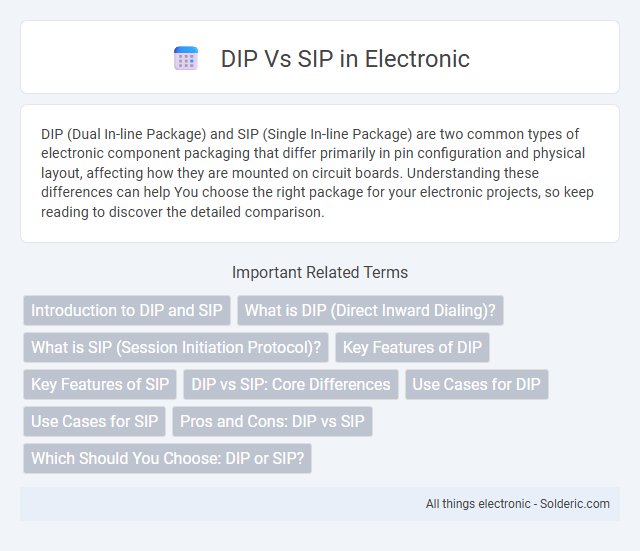DIP (Dual In-line Package) and SIP (Single In-line Package) are two common types of electronic component packaging that differ primarily in pin configuration and physical layout, affecting how they are mounted on circuit boards. Understanding these differences can help You choose the right package for your electronic projects, so keep reading to discover the detailed comparison.
Comparison Table
| Aspect | DIP (Dual In-line Package) | SIP (Single In-line Package) |
|---|---|---|
| Pin Configuration | Two parallel rows of pins | One single row of pins |
| Typical Uses | Microcontrollers, IC chips, sockets | Resistors arrays, capacitors, LEDs |
| Mounting Type | Through-hole mounting | Through-hole mounting |
| PCB Space | Wider footprint, requires more board space | Narrower footprint, space-efficient |
| Pin Count | Typically higher pin count available | Generally lower pin count |
| Assembly Complexity | Moderate complexity, easier to handle | Simpler due to single row of pins |
| Common Applications | Processor chips, memory modules | Signal conditioning, resistor packs |
Introduction to DIP and SIP
The Dependency Inversion Principle (DIP) advocates for high-level modules not to depend on low-level modules but both to depend on abstractions, reducing coupling and enhancing code flexibility. The Session Initiation Protocol (SIP) is a signaling protocol used for initiating, maintaining, and terminating real-time communication sessions such as VoIP calls and video conferencing. While DIP is a software design principle fundamental to decoupling components within software architecture, SIP focuses on managing multimedia communication sessions over IP networks.
What is DIP (Direct Inward Dialing)?
Direct Inward Dialing (DID), also known as Direct Inward Dialing (DID), is a telephony service that allows external callers to directly reach a specific extension within a private branch exchange (PBX) system without operator assistance. DID assigns individual phone numbers to various extensions, enabling efficient call routing and reducing the need for manual call forwarding. This feature optimizes communication workflows in businesses by providing direct access to departments or employees.
What is SIP (Session Initiation Protocol)?
Session Initiitiation Protocol (SIP) is a communication protocol used for initiating, maintaining, and terminating real-time sessions involving video, voice, messaging, and other multimedia applications over IP networks. SIP operates at the application layer and enables multimedia communication between endpoints by establishing sessions through signaling. It is widely implemented in Voice over IP (VoIP) systems, video conferencing, and unified communications, providing a standardized framework for session control.
Key Features of DIP
Dual In-line Package (DIP) features two parallel rows of pins for easy through-hole mounting on printed circuit boards, offering robust mechanical stability and straightforward manual soldering. DIP components are widely used in prototyping and legacy electronics due to their standardized pin spacing, which simplifies integration and replacement. Your circuit design benefits from DIP's compatibility with breadboards and sockets, enabling easy testing and upgrades.
Key Features of SIP
SIP (System in Package) integrates multiple ICs and components into a single package, offering compact design and improved performance through reduced interconnects. Key features of SIP include enhanced miniaturization, heterogeneous integration of diverse technologies, and improved thermal management. Your electronic devices benefit from SIP's ability to combine functionalities while optimizing space and power efficiency.
DIP vs SIP: Core Differences
DIP (Dual In-line Package) features through-hole mounting with pins extending perpendicularly from the package, while SIP (Single In-line Package) has a single row of pins suitable for compact circuit designs. DIP's wider pin spacing supports easier manual soldering and prototyping, whereas SIP offers a more space-efficient solution for high-density applications. Understanding these core differences helps optimize your component choice based on assembly method and PCB layout constraints.
Use Cases for DIP
Dual In-line Package (DIP) components are widely used in prototyping and educational settings due to their ease of handling and compatibility with breadboards and sockets. Their through-hole design offers robust mechanical stability, making them ideal for applications where durability is required, such as in industrial control systems and legacy hardware repair. You benefit from DIP's straightforward integration when designing low-volume or custom electronic circuits.
Use Cases for SIP
SIP (Session Initiation Protocol) is widely used for managing multimedia communication sessions such as voice and video calls over IP networks, making it ideal for VoIP telephony, video conferencing, and instant messaging applications. SIP's flexibility enables seamless integration with various devices and platforms, supporting business environments that require scalable and secure communication solutions. Your organization can leverage SIP for real-time collaboration, enhancing communication efficiency across distributed teams.
Pros and Cons: DIP vs SIP
Dual in-line packages (DIP) offer easy manual soldering and prototyping with through-hole mounting but can consume more PCB space and lack compactness. Surface-mount packages (SIP) provide higher component density and better electrical performance but require precise automated assembly and are harder to repair or modify. Choosing between DIP and SIP depends on your project's size constraints, assembly capabilities, and maintenance needs.
Which Should You Choose: DIP or SIP?
Choosing between DIP (Dual In-line Package) and SIP (Single In-line Package) depends on the specific application and space constraints. DIP components offer greater stability and ease of manual soldering, making them ideal for through-hole prototyping and repairs. SIP modules, with their compact single-row pin arrangement, are better suited for space-saving designs and automated assembly in industrial electronics.
DIP vs SIP Infographic

 solderic.com
solderic.com